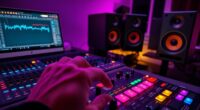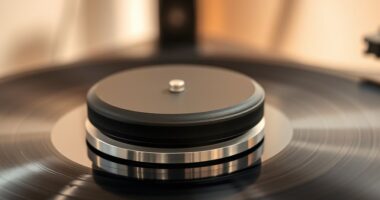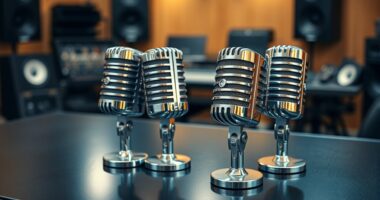If you’re looking for the 13 best guitar cab impulse loaders for studio and live sound in 2025, I recommend options like the SONICAKE IR Pedal, Leo Jaymz Pedal, EROK, and MOOER GE150 Plus, which offer versatile IR loading, multiple presets, and easy integration. These units provide authentic cabinet tones, great connectivity, and user-friendly controls for both recording and performances. Keep exploring, and you’ll discover even more tools to perfect your sound.
Key Takeaways
- Compact pedal-style IR loaders like SONICAKE, EROK, and Hotone offer quick IR loading and versatile cabinet simulation for studio and live use.
- Support for third-party IR files via USB or app enhances tonal flexibility and customization in professional and DIY setups.
- Multiple output options, including XLR and headphone jacks, ensure seamless integration with PA systems, mixers, and monitoring setups.
- Built-in EQ controls and extensive preset storage make these units ideal for precise tone shaping and live performance flexibility.
- Durable enclosures and user-friendly software simplify installation, operation, and ongoing updates, making them suitable for both beginners and experienced musicians.
SONICAKE IR Pedal Speaker Cabinet Simulator and Effects Pedal
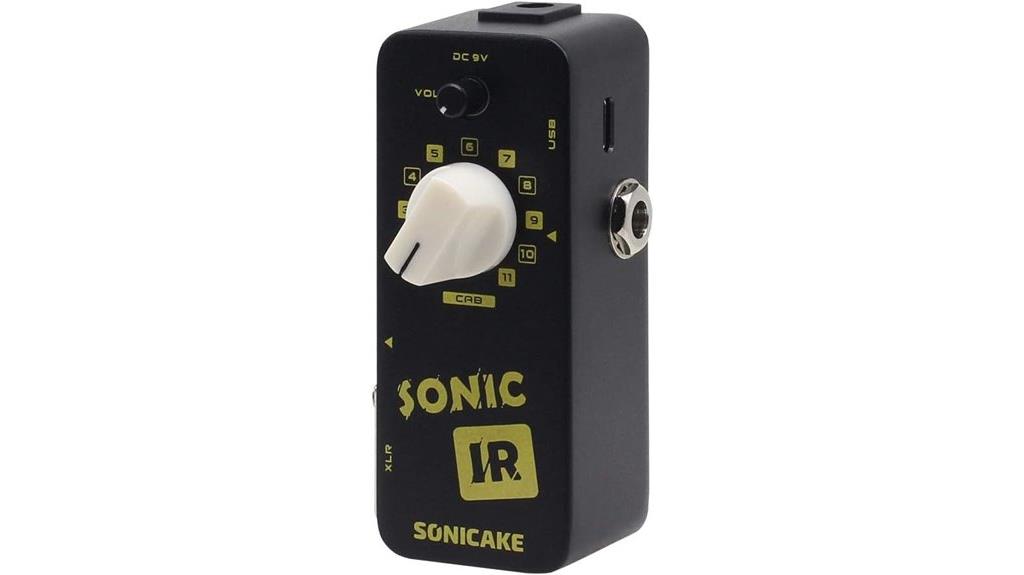
If you’re a guitarist or bassist looking for a straightforward way to achieve authentic cabinet tones, the SONICAKE IR Pedal is an excellent choice. It’s an impulse response loader that makes loading and managing IR files simple with drag-and-drop USB recognition. The pedal offers 11 on-board classic guitar and bass cabinet simulations, and you can easily adjust the volume for each. Its XLR balanced output lets me connect directly to mixers, audio interfaces, or PA systems, making it perfect for both live and studio use. Compact and easy to operate, this pedal delivers realistic speaker tones without fuss, streamlining my tone-shaping process.
Best For: guitarists and bassists seeking an easy-to-use, authentic cabinet simulation pedal for live and studio applications.
Pros:
- Simplifies IR loading with drag-and-drop USB file management for quick setup.
- Includes 11 on-board classic cabinet simulations with adjustable volume controls.
- Features XLR balanced output for seamless connection to mixers and PA systems.
Cons:
- Requires a 9V center-negative power supply, which is not included.
- Limited to 11 onboard cabinet models, may not cover all tonal preferences.
- Compact design might restrict extensive external connectivity options.
Leo Jaymz Guitar and Bass Effects Pedal with Presets and IR Cab Simulation
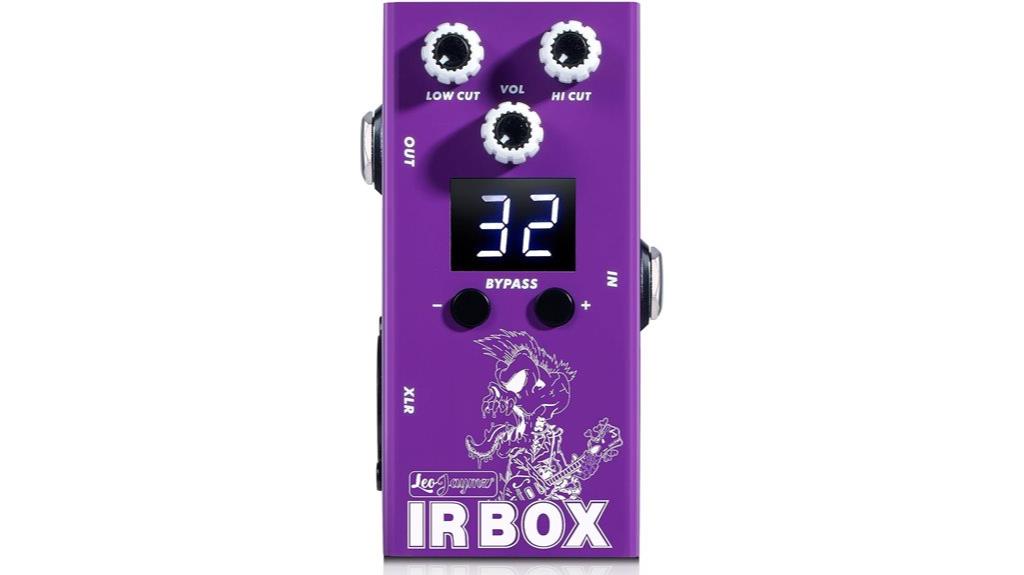
The Leo Jaymz Guitar and Bass Effects Pedal stands out as an excellent choice for musicians seeking versatile cab simulation in a compact, affordable package. With 32 built-in presets, including electric guitar and bass IRs, it offers high-quality sound with minimal noise and a broad tonal range. Its professional 9-band EQ allows precise tone shaping, and the ability to load third-party IR files via PC or mobile makes it highly customizable. Weighing just over 7 ounces, it’s perfect for pedalboards and portable practice. Overall, it delivers near-market-quality cab simulation at a fraction of the cost, making it a practical, versatile tool for recording and live performances.
Best For: musicians and recording enthusiasts seeking an affordable, versatile cab simulation pedal for practice, recording, and live performance.
Pros:
- High-quality sound with 103dB SNR and 44.1kHz/24-bit sampling rate
- Customizable with third-party IR loading via PC or mobile app
- Compact, lightweight design ideal for pedalboards and portable use
Cons:
- Small knobs and buttons may require dexterity, and lack of footswitches limits preset changes to manual control
- Initial software setup can be challenging, especially for new users
- Headphone output may have occasional issues for some users
QWORK Aluminium Stomp Box Enclosures, 5 Pack 4.42 x 2.38 x 1.22 Inches Guitar Pedal Enclosure

For DIY guitar pedal builders seeking durable, customizable enclosures, the QWORK Aluminium Stomp Box Enclosures offer an excellent solution. These enclosures come in a pack of five, made from sturdy aluminum diecast, providing solid protection for your effects pedals. Their natural, unpainted finish gives you a blank canvas to personalize with paint, engravings, or labels. Each measures 4.42 x 2.38 x 1.22 inches, fitting comfortably into pedalboards and accommodating various components. The package includes 20 screws, making assembly straightforward. Overall, these enclosures combine durability, versatility, and affordability—perfect for crafting reliable, professional-looking pedals.
Best For: DIY guitar pedal builders seeking durable, customizable enclosures for creating professional-looking effects pedals.
Pros:
- Made from sturdy aluminum diecast for robust protection and longevity
- Unpainted, natural finish offers a versatile blank canvas for customization
- Comes in a convenient pack of five with 20 screws for easy assembly
Cons:
- Limited color options due to unpainted metal finish
- Slightly larger dimensions may require precise fitting in some pedalboard setups
- No pre-drilled holes for specific components, requiring additional customization
EROK Speaker Cabinet Simulator Pedal with IR Loader
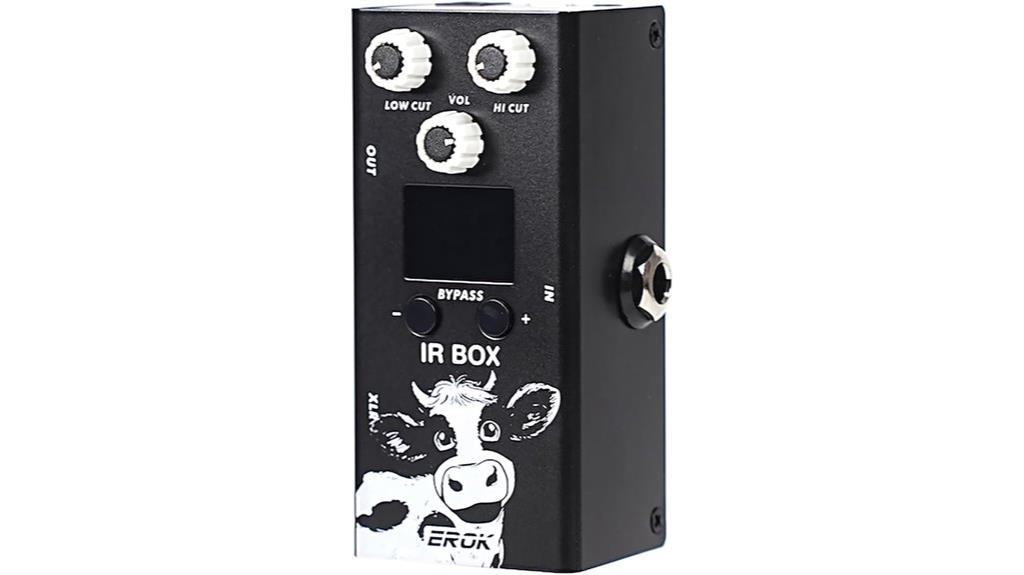
Designed for guitarists and bass players seeking authentic cabinet tones, the EROK Speaker Cabinet Simulator Pedal with IR Loader offers advanced IR support and customization options. It supports third-party IR file import, allowing you to tailor your sounds with 25 guitar and 7 bass presets, plus acoustic IRs. With a 9-band EQ, you can shape your tone precisely, and the pedal can function as a standalone EQ if needed. Its multiple outputs—including balanced XLR and stereo headphone—ensure seamless integration. Managed via a mobile app and PC software, you can easily load, modify, and save presets, making it a versatile tool for studio and live performances.
Best For: guitarists and bass players seeking authentic, customizable cabinet tones with advanced IR support for studio and live performance use.
Pros:
- Supports third-party IR files for highly personalized tone shaping
- Features a professional 9-band EQ with independent operation mode
- Multiple output options including balanced XLR and stereo headphone for versatile connectivity
Cons:
- Requires a mobile app or PC software for full functionality and preset management
- Power supply options may need careful attention to polarity and voltage specifications
- Initial setup and customization can be complex for beginners unfamiliar with IR and EQ parameters
MOOER GE150 Plus Guitar Multi-Effects Processor

If you’re looking for a versatile and portable multi-effects processor that can handle a wide range of tones, the MOOER GE150 Plus is a solid choice. It comes with 198 presets, offering plenty of options for different styles, plus 55 preamp models crafted with advanced technology to replicate classic amps accurately. You can load third-party IRs for cab simulation, giving you even more tonal flexibility. The effects section includes reverb, delay, and modulation, while features like an 80-second looper and built-in drums enhance creativity. Its compact design, USB connectivity, and intuitive controls make it perfect for both studio recording and live performances.
Best For: musicians and performers seeking a versatile, portable multi-effects processor with extensive tonal options for live playing, recording, and practice.
Pros:
- Offers 198 presets and 55 high-quality preamp models for diverse sound options.
- Supports loading third-party IRs for expanded cab simulation flexibility.
- Includes features like an 80-second looper, drum patterns, and intuitive controls for creative versatility.
Cons:
- May have a learning curve for beginners due to extensive features and settings.
- Limited built-in effects compared to some higher-end multi-effects units.
- The compact design, while portable, might restrict physical control for detailed editing.
Hotone Omni IR Cab Impulse Response Guitar and Bass Effects Pedal
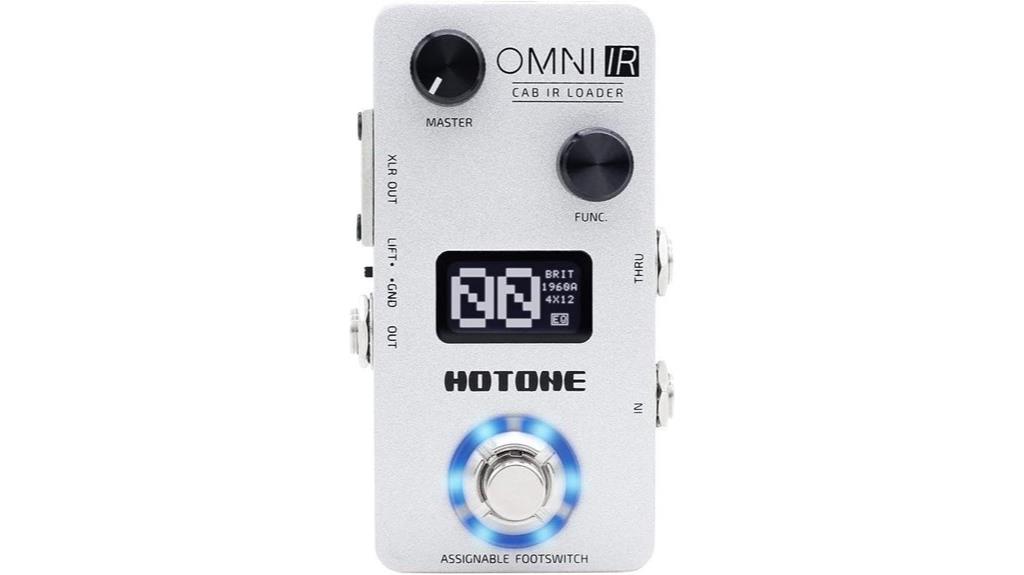
The Hotone Omni IR Cab Impulse Response Guitar and Bass Effects Pedal stands out as an excellent choice for players who want versatile speaker simulation and high-quality sound. It offers 40 legendary cabinet models and supports third-party IR files, allowing for custom speaker tones. With 100 presets and a detailed 4-band EQ, you can easily shape your tone to perfection. The 24-bit conversion ensures clear audio, while the OLED screen keeps you informed. Additional features like auxiliary input, headphone output, and an assignable footswitch make it ideal for both studio and live use. Powered by a standard 9V supply, it’s a flexible, professional-grade tool.
Best For: musicians and sound engineers seeking versatile speaker simulation and high-quality tone shaping for studio recordings and live performances.
Pros:
- Supports 40 legendary cabinet models plus third-party IR files for customized sounds
- 100 presets and detailed 4-band EQ for flexible tone shaping
- High-quality 24-bit A/D/A conversion ensures clear, professional sound
Cons:
- Requires a standard 9V DC power supply, which may necessitate additional accessories
- Limited to internal cabinet models and IR files, may need updates for new IRs
- Small OLED screen might be less visible in bright stage environments
NU-X | Pulse Impulse Response Pedal
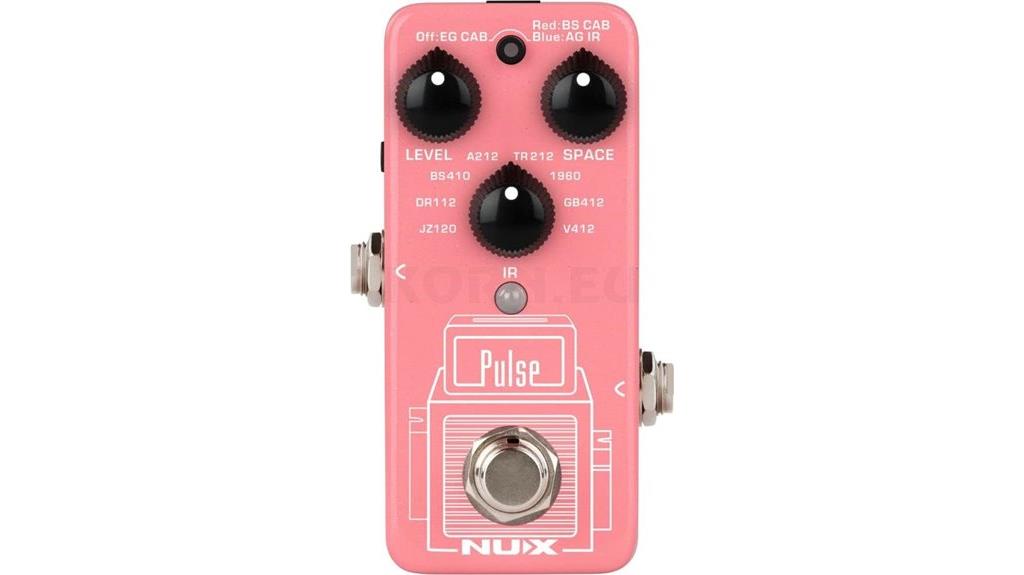
The NU-X Pulse Impulse Response Pedal stands out for guitar players seeking versatile tone shaping, thanks to its selectable IR modes—EG CAB, BS CAB, and AG IR—that allow you to tailor your cab simulations precisely. Its strong, lightweight aluminium chassis makes it durable and easy to transport. The pedal offers both buffered and true bypass options, giving you flexibility in your signal chain. Plus, with a USB-C port, you can connect to your PC or Mac for editing, firmware updates, and audio I/O. It requires a 9V power supply, making it a reliable, compact choice for studio and live use.
Best For: musicians and guitarists seeking versatile, customizable cab simulation and tone shaping options for both studio recording and live performances.
Pros:
- Offers multiple IR modes (EG CAB, BS CAB, AG IR) for tailored cab simulations.
- Durable, lightweight aluminium chassis for portability and robustness.
- Flexible connectivity with USB-C for editing, firmware updates, and audio I/O.
Cons:
- Requires a 9V power supply, which is not included.
- May have a learning curve for users unfamiliar with IR and tone editing.
- Limited to guitar and compatible instrument signals, not suitable for other audio sources.
FLAMMA FS07 Guitar Effects Pedal with Preset Slots and IR Support

For guitarists seeking versatile tone shaping, the FLAMMA FS07 Guitar Effects Pedal stands out with its extensive preset slots and IR support. It offers seven user preset slots, each capable of storing two different cabinet simulation settings, along with 11 factory IR files and the ability to load third-party IRs. The included editor software makes managing presets quick and straightforward. Keep in mind, it requires a 9V DC power supply with at least 304mA to function properly. This pedal is perfect for those who want high-quality stereo cabinet simulation combined with flexible IR loading for both studio and live performances.
Best For: guitarists seeking versatile tone shaping with extensive preset options and high-quality IR support for both studio and live performance settings.
Pros:
- Offers 7 user preset slots, each with dual cabinet simulation settings for maximum flexibility
- Supports loading third-party IR files, expanding tonal possibilities
- Includes dedicated editor software for easy preset management and editing
Cons:
- Requires a 9V DC power supply with at least 304mA, which is not included and must be purchased separately
- May have a learning curve for users unfamiliar with IR loading and software editing
- Limited factory IR files (11), potentially necessitating additional IR downloads for varied tones
Btuty M-VAVE Guitar IR Box Effects Pedal with IR Cab Impulse Response Cabinets Speaker Simulator
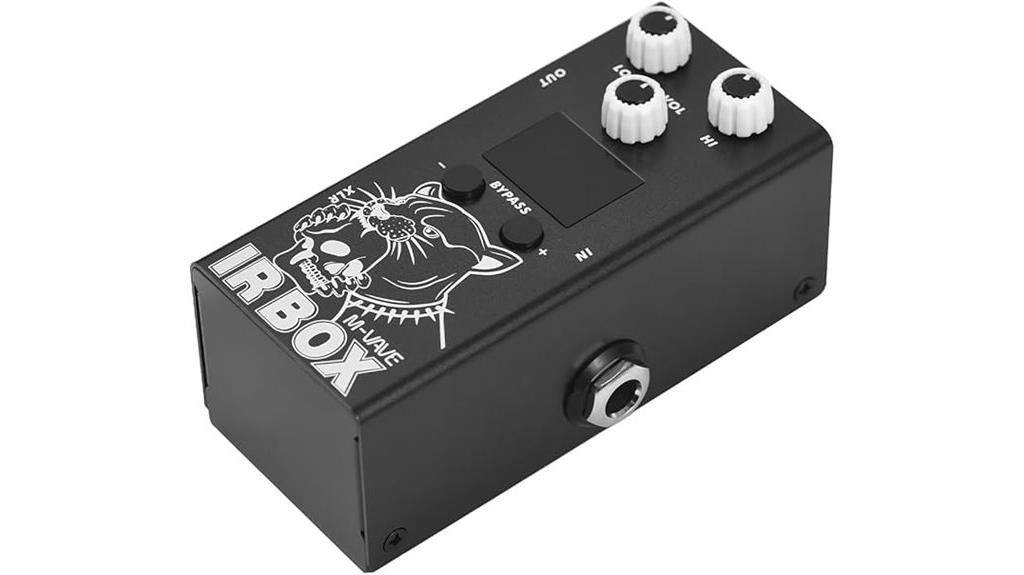
If you’re looking for an affordable and versatile solution to simulate cabinet tones, the Btuty M-VAVE Guitar IR Box Effects Pedal is an excellent choice. It offers 25 electric guitar and 7 electric bass cabinet presets, plus support for custom IR loading. Its true bypass guarantees clean signal flow, while the 6.35mm, XLR, and headphone outputs provide flexible connectivity for live or studio use. The pedal includes a 9-segment EQ, app control for quick preset management, and operates at a high sampling rate of 44.1kHz. Compact and lightweight, it’s perfect for musicians seeking realistic cab simulations without breaking the bank.
Best For: musicians and guitarists seeking an affordable, versatile cabinet simulation pedal for live performances or studio recordings.
Pros:
- Supports a wide range of IR cabinet presets and custom IR loading for versatile tone shaping
- Compact, lightweight design with true bypass for clean signal flow
- Multiple outputs including 6.35mm, XLR, and headphone jack for flexible connectivity
Cons:
- Limited gain and volume control options, which may affect complex pedal chain setups
- Some users report mild overdrive or volume drop issues in certain scenarios
- Basic EQ features with only 9 segments, offering less detailed tone adjustment
Strymon Iridium Amp and IR Cab Guitar Pedal

Musicians seeking a versatile, high-quality amp simulation pedal will find the Strymon Iridium ideal, especially if they want authentic tube amp tones without carrying heavy gear. It eliminates the need for bulky amps by delivering studio-grade sounds directly on your pedalboard. With three iconic tube amp models and nine stereo IR speaker cabinets, it offers a wide range of tonal options. The IR technology provides highly realistic responses, while the integrated reverb adds natural room ambiance. Designed for ease of use, Iridium is perfect for stage, studio, or practice, giving you professional-quality sound anywhere you perform or record.
Best For: musicians and guitarists seeking authentic, studio-grade amp tones and versatile sound options without the weight and bulk of traditional amplifiers.
Pros:
- Provides three iconic tube amp models with detailed tonal nuances through advanced Matrix Modeling technology.
- Includes nine stereo IR speaker cabinets and room ambiance reverb for highly realistic and immersive sound.
- Compact, easy to use, and suitable for stage, studio, or practice environments, eliminating the need for bulky gear.
Cons:
- Limited to three amp models, which may not cover every tonal preference or niche sound.
- High-resolution IR and advanced features might require some learning curve for beginners.
- As a digital pedal, it may lack the organic response of a real tube amplifier for purists seeking traditional tube feel.
Guitar Effect Pedal Amplifier Simulation for Electric Guitar
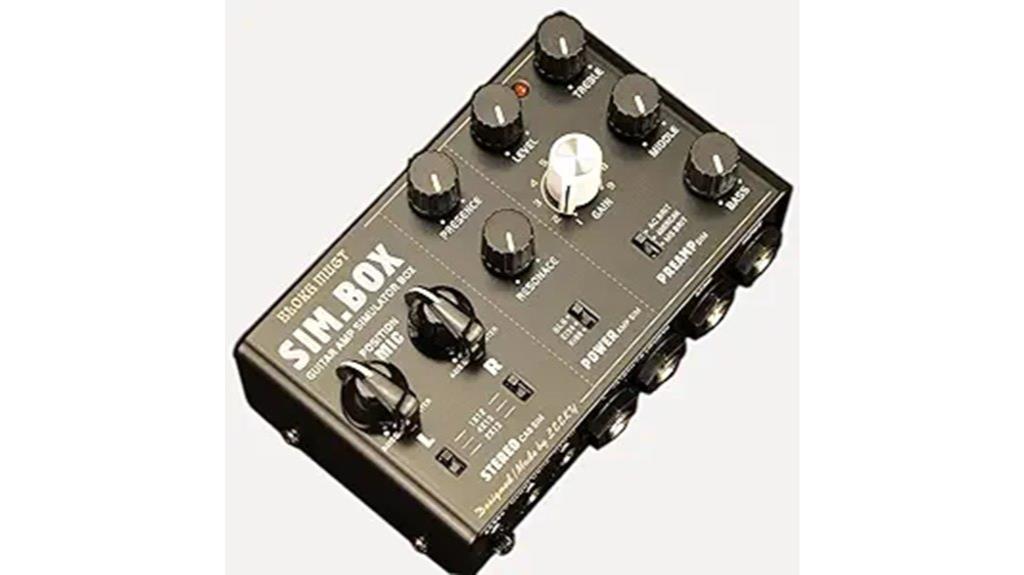
The Guitar Effect Pedal Amplifier Simulation stands out as an ideal solution for live performers and studio artists seeking a compact, versatile preamp that replicates classic amp tones. Its all-analog design delivers authentic tube breakup, a responsive tone stack, and cabinet simulation, all powered by a standard 9V supply. With three distinct amp voicings, it offers everything from American clean to British lead sounds, giving me full control over gain and midrange. The stereo cab simulation and FX pass-through let me integrate delays, reverbs, and boutique overdrives seamlessly. Perfect for stage or studio, this pedalboard-sized device simplifies setup and eliminates the need for traditional amps and cabinets.
Best For: live performers and studio artists seeking a compact, versatile preamp that authentically replicates classic amp tones without the need for traditional amps and cabinets.
Pros:
- All-analog design delivers authentic tube breakup and dynamic response
- Versatile with three distinct amp voicings covering a wide range of tones
- Seamless integration with effects pedals and stage/FOH setups via multiple outputs
Cons:
- Requires a standard 9V power supply (not included) which may need to be purchased separately
- Limited to pedalboard-sized form factor, which may limit extensive tone shaping options
- Might necessitate additional pedals or equipment for specific studio effects or complex rigs
Mako Series MKII ACS1 Amp Cab Simulator
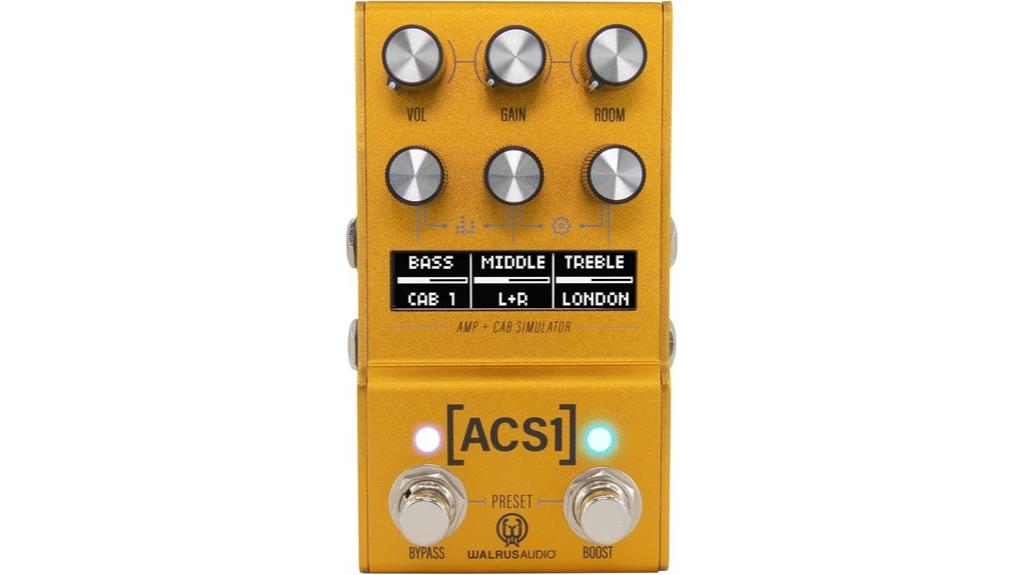
The Mako Series MKII ACS1 Amp Cab Simulator stands out for guitarists seeking an all-in-one, portable solution that offers authentic tone and versatile control. It features six amp models based on legendary classics, along with twelve high-quality IRs from Tone Factor and York Audio, ensuring rich, detailed sound. Its simple controls, onboard presets, and MIDI support make it easy to use live or in the studio. Weighing just over 12 ounces, it’s compact but delivers expansive tonal options, including adjustable room size. Overall, the ACS1 provides reliable, high-fidelity performance, making it an excellent choice for guitarists who want professional-grade tone in a portable package.
Best For: guitarists seeking a portable, all-in-one amp and cab modeling solution with high-fidelity tones for live performances and studio recording.
Pros:
- Authentic amp and cab modeling with six legendary amp profiles and twelve high-quality IRs from Tone Factor and York Audio.
- Compact, lightweight design weighing just over 12 ounces, ideal for stage, studio, or practice use.
- User-friendly interface with simple controls, onboard presets, MIDI support, and firmware/IR updates via walrusaudio.io.
Cons:
- Some users may find the price point higher compared to basic amp simulators.
- Limited to six amp models and twelve IRs, which might be restrictive for those seeking a broader range of tones.
- As a digital device, it may not fully replicate the nuance of traditional tube amps for purists.
IK Multimedia TONEX Pedal: Multi-Effects Guitar & Bass Pedal
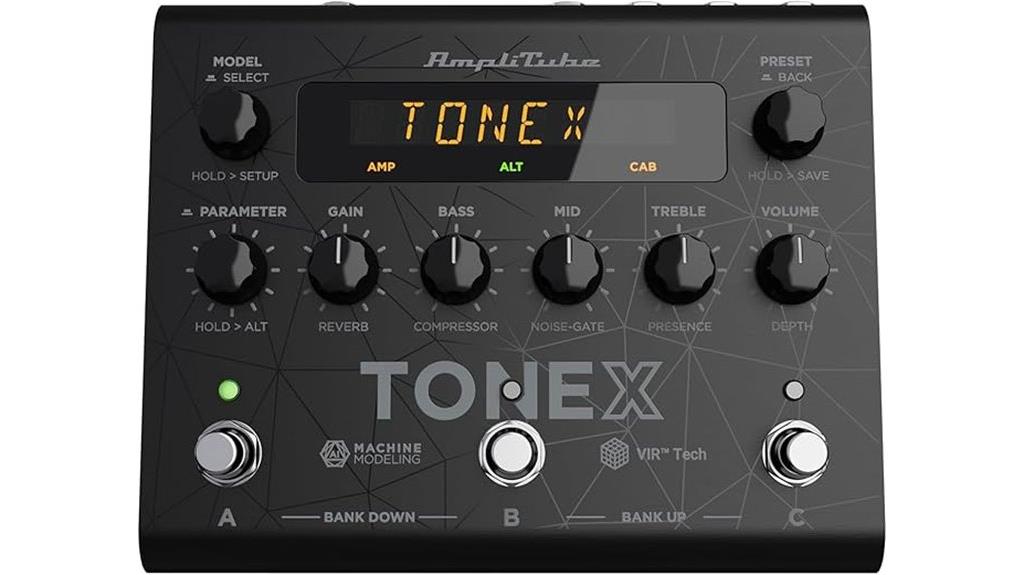
If you’re looking for a versatile multi-effects pedal that captures the true essence of your amp and pedal tones, the IK Multimedia TONEX Pedal is an excellent choice. It offers 150 presets with AI-powered tone modeling that deliver ultra-realistic amp and pedal sounds. You can access thousands of tones via ToneNET, browse, demo, and load signature models. The stereo effects engine provides flexible routing with 15 effects, including distortion, reverb, and delay. Authentic amp, cab, and pedal simulations, plus VIR multi-IR cabinets, add depth and clarity. Its onboard tuner, tap tempo, and headphone output make it perfect for both studio and stage use.
Best For: guitarists and bassists seeking a versatile, realistic multi-effects pedal with advanced tone modeling for live and studio use.
Pros:
- Offers 150 AI-powered presets with ultra-realistic amp and pedal tones.
- Extensive effects options with flexible stereo routing, including distortion, reverb, and delay.
- Authentic amp, cab, and pedal simulations with VIR multi-IR cabinets for clear, lifelike sound.
Cons:
- Not compatible as a standalone device with iOS; requires computer connection and subscription for tone library access.
- May have a learning curve for users unfamiliar with tone modeling and software integration.
- Built-in features designed mainly for guitar and bass, limiting versatility for other instruments.
Factors to Consider When Choosing Guitar Cab Impulse Loaders
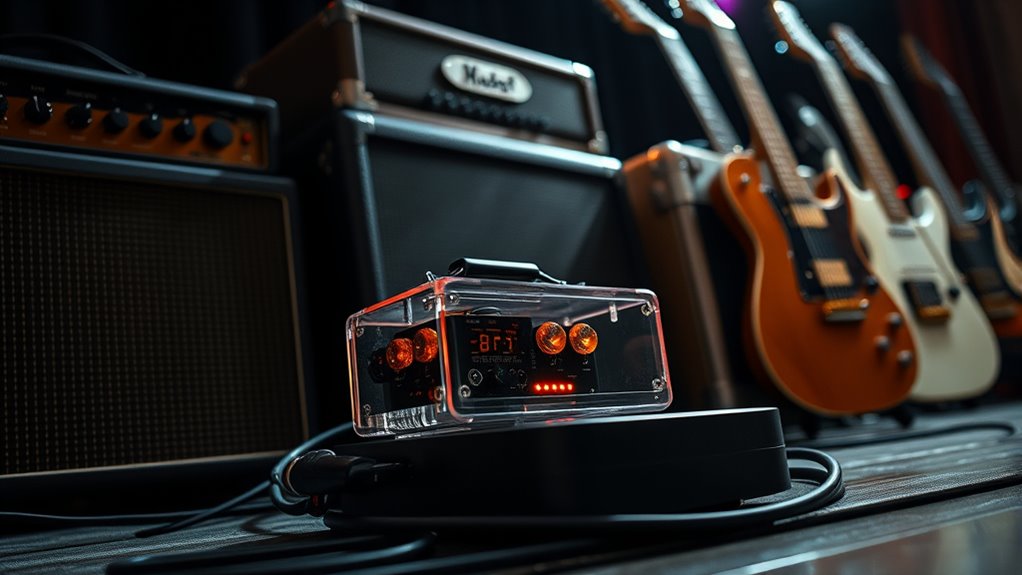
When choosing a guitar cab impulse loader, I focus on several key factors to guarantee it meets my needs. Compatibility with IR files, sound quality, and ease of use are top priorities, along with connectivity options and portability. Considering these points helps me find a loader that’s reliable, versatile, and simple to operate.
Compatibility With IR Files
Choosing a guitar cab impulse loader requires guaranteeing it can handle your preferred IR files without hassle. I look for loaders that support importing third-party IRs in common formats like WAV or IR-specific formats, giving me maximum flexibility. It’s also vital that the device’s interface makes loading, organizing, and managing my IR files straightforward. High sampling rate support, like 44.1kHz or higher, ensures I maintain audio fidelity for accurate sound reproduction. Compatibility with my operating system or platform—be it PC, Mac, iOS, or Android—is essential for smooth file management. Finally, I consider whether the loader allows adjustments such as IR volume or blending, which helps me tailor my cabinet sound precisely to my preferences. These factors ensure seamless integration and peak performance.
Sound Quality and Fidelity
High sound fidelity is vital for capturing the true character of guitar cabinet tones, and this begins with the sampling rate. I look for impulse loaders that operate at 24-bit/96kHz, ensuring detailed and accurate speaker simulations. The quality of impulse responses (IRs) is equally important; premium IR files deliver more authentic, realistic cabinet sounds. Low latency—under 1.5 milliseconds—helps preserve the natural response and feel, making the playing experience more genuine. Properly calibrated IR volume and EQ controls are essential for fine-tuning tonal balance and maintaining clarity without unwanted artifacts. Additionally, support for third-party IR files expands tonal options, allowing me to craft or select high-fidelity cabinet sounds tailored to my style and preferences.
Ease of Use & Interface
A user-friendly interface can make a significant difference in how smoothly I set up and operate guitar cab impulse loaders. Clear controls and menus simplify loading and managing IR files, saving time during setup or live performances. Features like drag-and-drop IR management or dedicated preset buttons allow quick access, which is essential in fast-paced environments. A well-designed display provides visual feedback on current IR selections, levels, and system status, making operation straightforward. Compatibility with mobile apps or PC software further enhances usability, enabling seamless preset editing, IR management, and system calibration. Overall, intuitive interfaces reduce the need for technical expertise, making these tools accessible to both beginners and professionals. This ease of use guarantees more focus on playing and performance rather than technical hurdles.
Output Options & Connectivity
When selecting a guitar cab impulse loader, it’s vital to evaluate its output options and connectivity features, as these determine how easily I can integrate it into my existing setup. I look for multiple output choices like 6.35mm, XLR balanced, and stereo headphone jacks to guarantee versatility. Supporting direct connections to mixers, audio interfaces, and PA systems through balanced or unbalanced outputs is essential for seamless integration. I also check if it supports external IR files via USB or app-based management, which expands tonal possibilities. Control interfaces like MIDI or USB are valuable for integrating into my effects chain. Additionally, quick and straightforward preset management helps me switch or edit output configurations swiftly during live performances or studio sessions.
Power Supply & Portability
Choosing the right guitar cab impulse loader depends heavily on its power supply options and portability features, as these determine whether it fits seamlessly into my setup and on the road. I look for devices compatible with common voltage standards like 9V DC or USB power, ensuring I can easily power them in different environments. Portability matters too; I consider size and weight to see if it fits on my pedalboard or in my gig bag without adding bulk. Battery operation is a big plus, giving me freedom during performances without relying solely on external power. Dual power input options, such as standard adapters and USB, add flexibility. Ultimately, I want a lightweight, compact unit that’s reliable and easy to transport, supporting my on-the-go playing needs.
Expandability and Software Support
Since expandability and software support directly impact how versatile and future-proof my guitar cab impulse loader is, I look for devices that can easily handle third-party IR files through dedicated software or apps. Compatibility with platforms like PC, Mac, iOS, or Android makes managing and updating IR libraries straightforward. Regular firmware updates from the manufacturer are also vital—they can introduce new features, support additional IR formats, and improve overall performance. Being able to load custom IRs allows me to tailor my tone precisely, whether I’m matching specific speakers or recording environments. An intuitive, versatile software interface simplifies managing presets, IR files, and system settings, making expansion seamless. This flexibility guarantees my gear remains adaptable as my needs evolve and technology advances.
Frequently Asked Questions
How Do Impulse Response Loaders Impact Overall Guitar Tone Quality?
Impulse response loaders markedly enhance my guitar tone by providing authentic cabinet sounds without needing physical mics or speakers. They capture the true character of a cab and allow me to shape my tone precisely. I find that they add depth, clarity, and a more natural feel to my sound, whether I’m recording or performing live. Overall, they give me more control and consistency, making my tone richer and more professional.
Can Impulse Load Models Be Customized for Unique Sound Preferences?
Did you know that 85% of guitarists customize their impulse responses? I can definitely say yes, impulse load models can be tailored to suit your unique sound preferences. I love experimenting with different cabinet and mic settings, and most impulse loaders allow easy tweaking or creating your own IRs. This customization helps me craft a signature tone, making my guitar sound exactly how I envision it.
What Are the Best Practices for Integrating Load Boxes With Traditional Amplifiers?
When integrating load boxes with traditional amps, I always start by ensuring compatibility and proper impedance matching. I connect the load box directly to my amplifier’s speaker output, then route the signal to my cab or recording system. I also keep my volume levels moderate to avoid damage. Regularly checking connections and testing the sound helps me maintain ideal tone and prevent issues during live or studio sessions.
How Do Impulse Response Loaders Affect Live Performance Reliability?
Did you know that 85% of live sound engineers report increased reliability when using impulse response loaders? I’ve found that these loaders substantially improve live performance stability by providing consistent tone, reducing setup time, and minimizing technical issues. They also allow me to easily switch between sounds without hassle. Overall, impulse response loaders boost my confidence on stage, ensuring my tone stays reliable and professional no matter the gig.
Are There Compatibility Concerns Between Different Impulse Response Formats and Pedals?
Yes, there can be compatibility concerns between different impulse response formats and pedals. I always check if my pedal supports formats like WAV, AIFF, or proprietary ones before loading new IRs. Some pedals are limited to specific formats, so mismatched files might not work or cause quality issues. To avoid surprises, I keep a list of compatible IR formats and use converters when needed.
Conclusion
Choosing the right guitar cab impulse loader is like finding the perfect lens for a photographer—each one shapes your sound uniquely. Whether you’re after studio clarity or live punch, these options offer a spectrum of possibilities. Remember, it’s not just about gear, but about capturing your tone’s true essence. Immerse yourself, experiment, and let your sound shine through, just like a master painter with their canvas.

